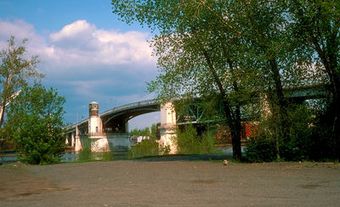Mont-Saint-Hilaire
Mont-Saint-Hilaire, Qué, Town, pop 15 720 (2006c), 14 270 (2001c), inc 1966. Mont-Saint-Hilaire is located about 35 km east from MONTRÉAL on the Rivière RICHELIEU opposite BELOEIL. Cosily nestled between Mont Saint-Hilaire, the highest of the Monteregian Hills (411 m), and the Rivière Richelieu, Mont-Saint-Hilaire was created out of the merger of the original village of Saint-Hilaire (1855) with the town of Mont-Saint-Hilaire (1950). The name recalls Saint-Hilaire, Bishop of Poitiers (315-67), who was made famous for his stand against Arianism.History
This area, part of the seigneury granted to Jean-Baptiste Hertel de Rouville in 1694, was sufficiently settled at the end of the 18th century to warrant the creation of a mission church, Saint-Hilaire. In 1844, the seigneury was sold to Major Thomas Edmund Campbell, who invested a great deal in the development of his domain, transforming the old manor house into a fine Tudor-style mansion, building a grist mill (Guérin House) and investing in a railway linking Saint-Hilaire to the Montréal area. He encouraged the apple, cider and maple sugar industries, so typical still of that region of the province. The area's apple orchards and the museum of Cidrerie du Verger Gaston are local attractions.
Present Day
Mont-Saint-Hilaire was home to the renowned artists Ozias LEDUC, Paul-Émile BORDUAS and Jordi BONET. It boasts several centres for the arts and art galleries, the main ones being Musée d'art de Mont-Saint-Hilaire, Centre d'art Ozias Leduc et galerie d'art contemporain, Ateliers du Faubourg des arts and Manoir Rouville-Campbell. These artists are featured in the Musée des beaux-arts de Mont-Saint-Hilaire and the museum has acquired the homes of Leduc and Borduas. Arts Station is a performing arts venue. The MONT ST-HILAIRE NATURE CONSERVATION CENTRE GAULT NATURE RESERVE, a McGill University research station, is a well-known bird refuge and was the stimulus for Canada's first UNESCO BIOSPHERE RESERVE (1978).

 Share on Facebook
Share on Facebook Share on X
Share on X Share by Email
Share by Email Share on Google Classroom
Share on Google Classroom

